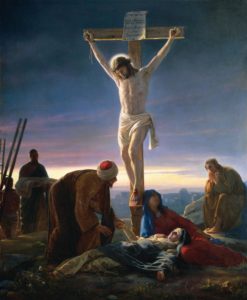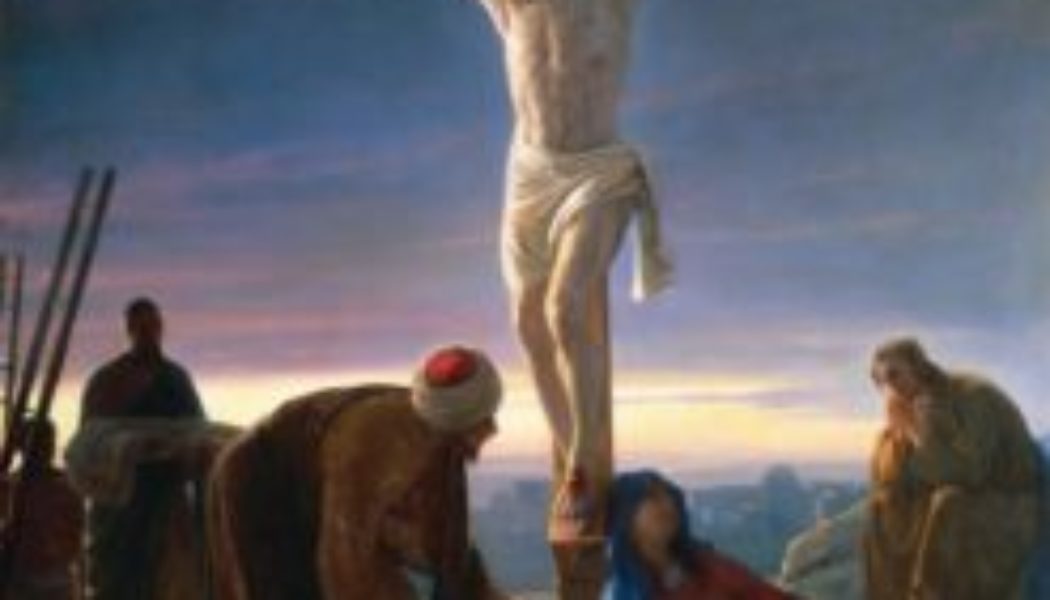 We do well to ponder the whys and wherefores of the Passion of Our Lord. St. Thomas Aquinas presents the premise that God does nothing in an arbitrary way, but rather as Lord of History sets forth everything in fitting ways and at appropriate places and times. Every detail has something to teach us.
We do well to ponder the whys and wherefores of the Passion of Our Lord. St. Thomas Aquinas presents the premise that God does nothing in an arbitrary way, but rather as Lord of History sets forth everything in fitting ways and at appropriate places and times. Every detail has something to teach us.
Let’s consider why Christ suffered in Jerusalem (but outside its walls) in a place called “the skull.” St. Thomas covered these matters in his Summa Theologiae, Part III, Question 46, Article 10. His words are in bold, black italics; my inferior comments are shown in plain red text.
Christ died most appropriately in Jerusalem. First of all, because Jerusalem was God’s chosen place for the offering of sacrifices to Himself: and these figurative sacrifices foreshadowed Christ’s Passion
For the Jewish people of that time, there was only one place to offer sacrifices to the Lord: Jerusalem. Although towns had synagogues, only Jerusalem had the Temple, and one had to go there to offer sacrifices to the Lord.
This rule had become quite firm. Indeed, even when Temple sacrifices were interrupted during the Babylonian captivity (the Temple was destroyed in in 587 B.C. and not rebuilt until about 70 years later), rather than relocate the place for sacrifice, the people lamented, We have in our day no prince, prophet, or leader, no burnt offering, sacrifice, oblation, or incense, no place to offer first fruits, to find favor with you (Daniel 3:38).
Therefore, because salvation is from the Jews (Jn 4:22), it was fitting that Christ, our Paschal Lamb and perfect, once-for-all sacrifice, was sacrificed in the only acceptable place.
Secondly, because the virtue of His Passion was to be spread over the whole world, He wished to suffer in the center of the habitable world–that is, in Jerusalem. Accordingly, it is written, “But God is our King before ages: He hath wrought salvation in the midst of the earth” (Psalm 73:12)—that is, in Jerusalem, which is called “the navel of the earth.”
A glimpse at a map shows that Jerusalem is arguably at the very intersection of three continents: Europe, Asia, and Africa. Psalm 48:2 reads, Mount Zion, true pole of the earth, the Great King’s city!
Thirdly, because it was specially in keeping with His humility: that, as He chose the most shameful manner of death, so likewise it was part of His humility that He did not refuse to suffer in so celebrated a place.
Not only was Christ’s humiliation very public, it occurred when Jerusalem was packed for the Passover feast!
Fourthly, He willed to suffer in Jerusalem, where the chief priests dwelt, to show that the wickedness of His slayers arose from the chiefs of the Jewish people.
Jerusalem had the reputation of being the place where prophets suffered the most and where most of them went to die. This is likely because it was there that faith and power intersected. Human beings seldom negotiate that intersection well and the scale is tipped more to power than to faith.
-
-
- Jesus said, Jerusalem, Jerusalem, who kills the prophets and stones those sent to her! How often I have longed to gather your children together as a hen gathers her chicks under her wings, but you were unwilling. Look, your house is left to you desolate. And I tell you, you will not see Me again until you say, “Blessed is He who comes in the name of the Lord” (Luke 13:34-35).
- Jesus said, Woe to you, because you build tombs for the prophets, and it was your ancestors who killed them. So you testify that you approve of what your ancestors did; they killed the prophets, and you build their tombs. Because of this, God in his wisdom said, “I will send them prophets and apostles, some of whom they will kill and others they will persecute.” Therefore, this generation will be held responsible for the blood of all the prophets that has been shed since the beginning of the world, from the blood of Abel to the blood of Zechariah, who was killed between the altar and the sanctuary. Yes, I tell you, this generation will be held responsible for it all. (Luke 11:47-51).
- Stephen added, You stiff-necked people, uncircumcised in heart and ears, you always resist the Holy Spirit. As your fathers did, so do you. Which of the prophets did your fathers not persecute? And they killed those who announced beforehand the coming of the Righteous One, whom you have now betrayed and murdered, you who received the law as delivered by angels and did not keep it (Acts 7:51-53).
-
These teachings, fitting though they are, give rise to these questions: If Jerusalem was the appropriate place, why was Jesus not sacrificed on the Temple mount, inside the city? Why was He instead sacrificed outside the city gates? St. Thomas answers this as follows:
For three reasons Christ suffered outside the gate, and not in the Temple nor in the city. First of all, that the truth might correspond with the figure. For the calf and the goat which were offered in most solemn sacrifice for expiation on behalf of the entire multitude were burnt outside the camp, as commanded in Leviticus 16:27.
Note the distinction between the sacrifice of an individual family (which was offered at the temple and burnt on the altar there) and the sacrifice offered on behalf of all the people on the Day of Atonement. Leviticus 16:27 says, The bull and the goat for the sin offerings, whose blood was brought into the Most Holy Place to make atonement, must be taken outside the camp; their hides, flesh and intestines are to be burned up. Therefore, it is fitting that Christ, who died for all, should be sacrificed outside the gate (“outside the camp,” as it were).
Secondly, to set us the example of shunning worldly conversation. Accordingly, the passage continues: “Let us go forth therefore to Him without the camp, bearing His reproach.”
Out worldly categories and notions cannot contain Christ. In His time there were at least three political and religious groups: the Sadducees, the Pharisees, and the Zealots. Jesus walked with none of them; neither did He simply parrot their views. There was only one thing the groups could agree on—Jesus had to go. Thus, fitting nowhere, Christ was crucified outside the camp.
Thirdly, as Chrysostom says in a sermon on the Passion (Hom. i De Cruce et Latrone): “The Lord was not willing to suffer under a roof, nor in the Jewish Temple…lest you might think He was offered for that people only. Consequently, it was beyond the city and outside the walls, that you may learn it was a universal sacrifice, an oblation for the whole world, a cleansing for all.”
He suffered once and for all. As Jesus said to the Samaritan woman at the well, A time is coming when you will worship the Father neither on this mountain nor in Jerusalem. You Samaritans worship what you do not know; we worship what we do know, for salvation is from the Jews. Yet a time is coming and has now come when the true worshipers will worship the Father in the Spirit and in truth, for they are the kind of worshipers the Father seeks. God is spirit, and his worshipers must worship in the Spirit and in truth (Jn 4:21-24).
St. Thomas presents two additional reasons that Jesus was crucified where He was, noting especially the name of the place: Golgotha. Although Aquinas described both reasons, he concluded that only one is correct.
According to Jerome, in his commentary on Matthew 27:33, someone explained “the place of Calvary” as being the place where Adam was buried; and that it was so called because the skull of the first man was buried there. A pleasing interpretation indeed, and one suited to catch the ear of the people, but, still, not the true one. … [For] Adam was buried close by Hebron and Arbe, as we read in the book of Jesus Ben Nave.
To this day, in the Church of the Holy Sepulcher there is a small opening or cave at the base of Golgotha that is venerated by some as the tomb of Adam. One can stop in there prior to climbing the stairs to Calvary. Legend has it that the Blood of Christ dripped though the opening and touched the bones of Adam, causing him to get up and dance a jig.
St. Thomas was not impressed with such legends or even with the teaching of St. Jerome; instead, he offered another interpretation.
For the spots where the condemned are beheaded are outside the city and beyond the gates, deriving thence the name of Calvary—that is, of the beheaded. Jesus, accordingly, was crucified there, that the standards of martyrdom might be uplifted over what was formerly the place of the condemned. … [So] Jesus was to be crucified in the common spot of the condemned rather than beside Adam’s sepulcher, to make it manifest that Christ’s cross was the remedy, not only for Adam’s personal sin, but also for the sin of the entire world.
Martyrs die for Christ, not as mere condemned criminals. And though Christ did die for all, not just for Adam, the primordial sin was Adam’s.
It is curious to me that St. Thomas, writing in a style somewhat out of keeping with his usually reserved way, so forcefully set aside St. Jerome’s interpretation. Perhaps we can learn something from both views! This is especially the case because the location of Adam’s burial remains a matter of dispute to this day, with many continuing to venerate the site beneath Calvary.






